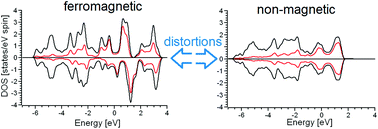Unveiling the origin of room-temperature ferromagnetism in monolayer VSe2: the role of extrinsic effects†
Abstract
Room-temperature ferromagnetism in monolayer vanadium diselenide (VSe2) on graphite is the object of a controversial debate. Herein, we unveil the contribution from extrinsic factors to the magnetic properties of monolayer VSe2 by means of density functional theory. Specifically, we demonstrate that either intrinsic defects or the adsorption of molecules enhances ferromagnetic interactions. The expansion of the VSe2 lattice increases the magnetic moment on vanadium ions, whereas both compression and out-of-plane distortion withdraw magnetic moments. The exchange interactions between vanadium ions and magnetic defects (vacancies and impurities) in the surface and subsurface layers of the substrate are able to turn the unstable two-dimensional (2D) ferromagnetism into stable three-dimensional (3D) ferromagnetism. Definitely, the combination of effects related to chemisorption, substrate-induced distortion and magnetic defects of the substrate could enhance or suppress ferromagnetism in monolayer VSe2.



 Please wait while we load your content...
Please wait while we load your content...